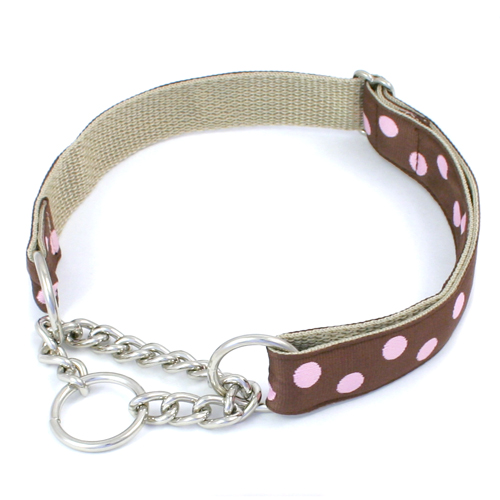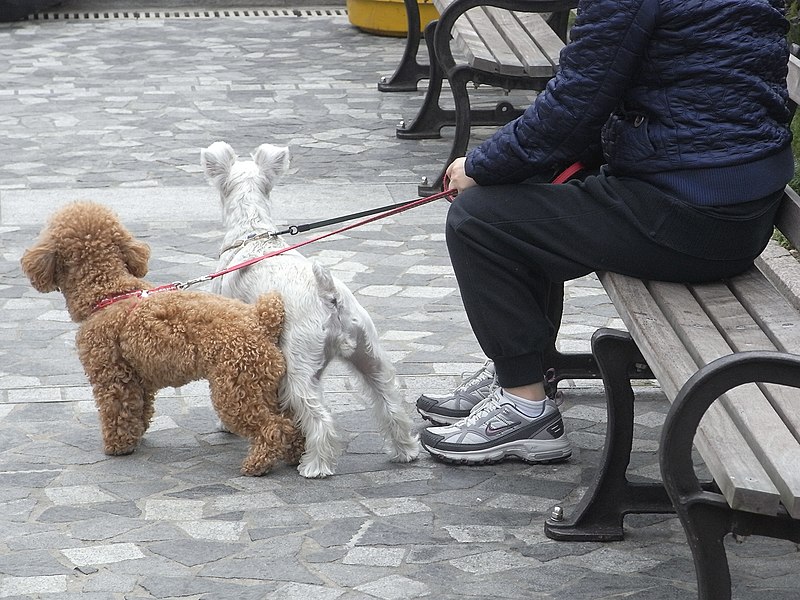So you got a new puppy or adopted a new forever friend and now you’re in a mad dash to find the perfect accessories for your new pet. It seems like it should be an easy thing to do, but your choice may not be so cut-and-dry once you’re faced with a row of products to pick from. Lets talk a little about some of the popular products and maybe the decision making process will be a little easier for you.
Collars
There are lots of different collars on the market made of lots of different materials and designed to help you best handle your pet. You can find collars constructed of nylon, rubber, vinyl, leather, recycled materials, natural fiber like hemp or bamboo, or metal; some are embellished with gems, ribbons or other decorations. Typically, the material of the collar is choosen for durability and to appeal to you, the handler. These materials are also used to provide the ultimate comfort to your pet. For the most part these materials are inert, but on rare occasions dogs with sensitive skin or skin allergies may develop skin irritations to some materials. If you notice frequent itching or irritation around your pet’s neck, you may need to consider a collar of a different style or material. A collar of any of these materials can have a long life…but your choice should be influenced by your dog’s personality and lifestyle. The most popular collars are basic, reliable woven (or leather) with either metal or plastic buckles. These collars are easy to adjust, easy to clean, and perfect for everyday wear. Rubber and rubber-coated “ultimate” collars share a similar design, but are resistant to water, odors and stains, great for swimmers or sporting dogs!
 There are also specialty collars designed to suit specific body types, activities and to provide you with more control if necessary. These collar types are best suited for outings, not necessarily extended wear. You may find a martingale collar perfect for breeds with slim heads or small ears, like greyhounds and whippets. Martingale collars tighten when pressure is applied on the lead, preventing the dog from slipping the collar. They loosen if the dog doesn’t pull, and the wide constriction provides ultimate comfort. Chain collars and prong collars share similar design, tightening when the dog pulls and easing when the dog is walking calmly. Metal collars aren’t for everyone, but they are meant to control strong pullers, and if used carefully and properly they can be effective. Chain and prong collars should not be used on small dogs, dogs of slender build, breeds that tend to have breathing issues (short nosed breeds), or any dog under a year of age.
There are also specialty collars designed to suit specific body types, activities and to provide you with more control if necessary. These collar types are best suited for outings, not necessarily extended wear. You may find a martingale collar perfect for breeds with slim heads or small ears, like greyhounds and whippets. Martingale collars tighten when pressure is applied on the lead, preventing the dog from slipping the collar. They loosen if the dog doesn’t pull, and the wide constriction provides ultimate comfort. Chain collars and prong collars share similar design, tightening when the dog pulls and easing when the dog is walking calmly. Metal collars aren’t for everyone, but they are meant to control strong pullers, and if used carefully and properly they can be effective. Chain and prong collars should not be used on small dogs, dogs of slender build, breeds that tend to have breathing issues (short nosed breeds), or any dog under a year of age.
Choose a collar you like and that suits your pet. Be sure to adjust the collar so that it fits properly. The collar should be tight enough that it can’t slip over the head and ears easily, but loose enough that you can slip two fingers between the collar and the dog’s neck. I prefer to remove my dog’s collar while she’s in the house, and I think they like the reprieve of being “naked” while relaxing at home.
Harnesses and Halters
If your dog is a tough puller or finds ways to slip a collar somehow every time, a harness or a halter may be a better option for you. These accessories also increase control and ease pressure on your pet’s neck to avoid accidental injury to the area when they lunge or strain. Halters and harnesses come in several different styles, materials and a rainbow of colors too. Harnesses slip over the dog’s legs and increase control by holding the dog around its chest. Most harnesses are easy to put on and able to be adjusted at at least two points to ensure proper fit. They are particularly suitable for those short-nosed breeds like pugs, bulldogs and Bostons. Halters fit over the muzzle, gently pull the dog’s face when they pull. This pressure forces the dog to pull less if they want to lead the way. Harnesses and halters are not meant to be worn all the time, but can be great tools for when you’re out and about.
Leashes and Leads

I hope this little blurb helps to explain the differences in some of the products offered to make your new endeavor a success. Please let us know if you have questions on what might be the right accessory for you, we’ll be happy to suggest a good fit for your situation.
Dogs at dog park image referenced from wikipedia and originally posted by Shopmimigreen
Dogs at dog park image referenced from wikipedia and originally posted by Snowacinesy
 That Pet Blog That Pet Place Pet Blog
That Pet Blog That Pet Place Pet Blog

Thank you for this wonderful guide on collars, leashes and harnesses/halters. Lots of nuggets of information in there!
Great article. Be sure that you get a tag to go with the collar. We get a number of pets posted to our site, lostandfoundhound.com who have collars, but no tags.
You should check out this new web-based animal reality show called Animal Movers. It is about a pet transportation company that moves animals all around the world. They move many different types of animals. The first episode was about moving Rhodesian Ridgebacks to Hawaii. It was very interesting and family friendly.
Great article, I completely agree with everything you say. Harnesses are also great for dogs at risk for neck disk disease such as beagles. surgery for a slipped neck disk comes in the $2-3000 range so anything thing you can do to prevent it is worth a try!
Thank you for this well written blog post on collars, leads and halters for dogs. It is definitely not easy caring for pets. It takes time, dedication and love to really take up such a huge responsibility. There are loads of products out there in the market, which might leave the dog lovers wondering it’s purpose and function. This blog post illustrates exactly what purpose and function the different products provide. I do agree that leads can aid in training your dogs to be more obedient. I also agree that it is important to note that some dogs suffer from sensitive skin, thus it is very crucial to consider the material of products.